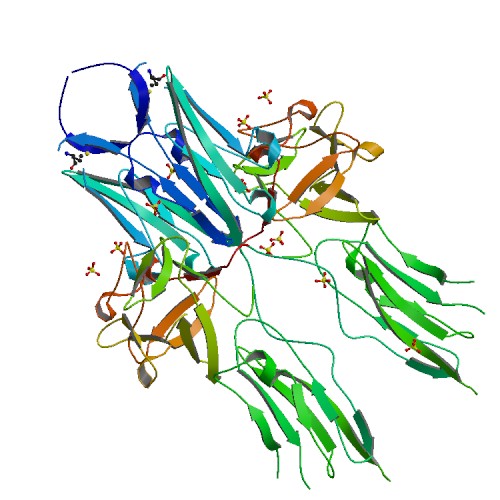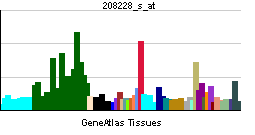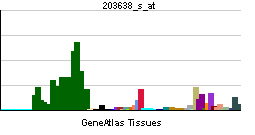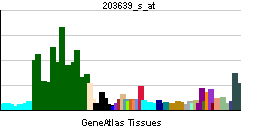Fibroblast growth factor receptor 2
| Fibroblast growth factor receptor 2 (bacteria-expressed kinase, keratinocyte growth factor receptor, craniofacial dysostosis 1, Crouzon syndrome, Pfeiffer syndrome, Jackson-Weiss syndrome) | |||||||||||||
|---|---|---|---|---|---|---|---|---|---|---|---|---|---|
 PDB rendering based on 1djs. | |||||||||||||
| |||||||||||||
| Identifiers | |||||||||||||
| Symbols | FGFR2 ; BEK; BFR-1; CD332; CEK3; CFD1; ECT1; JWS; K-SAM; KGFR; TK14; TK25 | ||||||||||||
| External IDs | Template:OMIM5 Template:MGI HomoloGene: 22566 | ||||||||||||
| |||||||||||||
| RNA expression pattern | |||||||||||||
 | |||||||||||||
 | |||||||||||||
 | |||||||||||||
| More reference expression data | |||||||||||||
| Orthologs | |||||||||||||
| Template:GNF Ortholog box | |||||||||||||
| Species | Human | Mouse | |||||||||||
| Entrez | n/a | n/a | |||||||||||
| Ensembl | n/a | n/a | |||||||||||
| UniProt | n/a | n/a | |||||||||||
| RefSeq (mRNA) | n/a | n/a | |||||||||||
| RefSeq (protein) | n/a | n/a | |||||||||||
| Location (UCSC) | n/a | n/a | |||||||||||
| PubMed search | n/a | n/a | |||||||||||
Fibroblast growth factor receptor 2 (FGFR2) is a receptor for fibroblast growth factor on chromosome 10 . The protein encoded by this gene is a member of the fibroblast growth factor receptor family, where amino acid sequence is highly conserved between members and throughout evolution. FGFR family members differ from one another in their ligand affinities and tissue distribution. A full-length representative protein consists of an extracellular region, composed of three immunoglobulin-like domains, a single hydrophobic membrane-spanning segment and a cytoplasmic tyrosine kinase domain. The extracellular portion of the protein interacts with fibroblast growth factors, setting in motion a cascade of downstream signals, ultimately influencing mitogenesis and differentiation. This particular family member is a high-affinity receptor for acidic, basic and/or keratinocyte growth factor, depending on the isoform. Mutations in this gene are associated with Crouzon syndrome, Pfeiffer syndrome, Craniosynostosis, Apert syndrome, Jackson-Weiss syndrome, Beare-Stevenson cutis gyrata syndrome, Saethre-Chotzen syndrome, and syndromic craniosynostosis. Alternatively spliced variants which encode different protein isoforms have been described; however, not all variants have been fully characterized.[1]
Clinical significance
Mutations (changes) are associated with several medical condition:
- Apert syndrome, the best-known type of acrocephalosyndactyly. This condition is characterized by abnormalities of the skull and face and the hands and feet.
- Pfeiffer syndrome (another type of acrocephalosyndactyly). Inherited as dominant trait.
- Crouzon syndrome (purely a craniofacial disorder with no hand or foot problems). Inherited as dominant trait.
- Jackson-Weiss syndrome
- Breast cancer[2]
See also
References
- ↑ "Entrez Gene: FGFR2 fibroblast growth factor receptor 2 (bacteria-expressed kinase, keratinocyte growth factor receptor, craniofacial dysostosis 1, Crouzon syndrome, Pfeiffer syndrome, Jackson-Weiss syndrome)".
- ↑ Hunter DJ, Kraft P, Jacobs KB; et al. (2007). "A genome-wide association study identifies alleles in FGFR2 associated with risk of sporadic postmenopausal breast cancer". doi:10.1038/ng2075. PMID 17529973.
Further reading
- McKeehan WL, Kan M (1995). "Heparan sulfate fibroblast growth factor receptor complex: structure-function relationships". Mol. Reprod. Dev. 39 (1): 69–81, discusison 81-2. doi:10.1002/mrd.1080390112. PMID 7999363.
- Johnson DE, Williams LT (1993). "Structural and functional diversity in the FGF receptor multigene family". Adv. Cancer Res. 60: 1–41. PMID 8417497.
- Park WJ, Meyers GA, Li X; et al. (1996). "Novel FGFR2 mutations in Crouzon and Jackson-Weiss syndromes show allelic heterogeneity and phenotypic variability". Hum. Mol. Genet. 4 (7): 1229–33. PMID 8528214.
- Marie PJ, Debiais F, Haÿ E (2003). "Regulation of human cranial osteoblast phenotype by FGF-2, FGFR-2 and BMP-2 signaling". Histol. Histopathol. 17 (3): 877–85. PMID 12168799.
- Ibrahimi OA, Chiu ES, McCarthy JG, Mohammadi M (2005). "Understanding the molecular basis of Apert syndrome". Plast. Reconstr. Surg. 115 (1): 264–70. PMID 15622262.
- Wilkie AO (2005). "Bad bones, absent smell, selfish testes: the pleiotropic consequences of human FGF receptor mutations". Cytokine Growth Factor Rev. 16 (2): 187–203. doi:10.1016/j.cytogfr.2005.03.001. PMID 15863034.
External links
- Fibroblast+Growth+Factor+Receptor+2 at the US National Library of Medicine Medical Subject Headings (MeSH)
| Stub icon | This enzyme-related article is a stub. You can help Wikipedia by expanding it. |